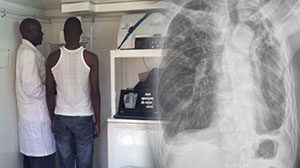Automatic X-Ray Screening for Rural Areas
Executive Summary
 The Lister Hill National Center for Biomedical Communication, an intramural R&D division of the National Library of Medicine (NLM) part of the National Institutes of Health (NIH), conducts R&D in biomedical image processing, medical informatics and the use of advanced communications and computing technologies to improve delivery of clinical data and health information to consumers, health care providers, and researchers.
The Lister Hill National Center for Biomedical Communication, an intramural R&D division of the National Library of Medicine (NLM) part of the National Institutes of Health (NIH), conducts R&D in biomedical image processing, medical informatics and the use of advanced communications and computing technologies to improve delivery of clinical data and health information to consumers, health care providers, and researchers.
The NLM has an ongoing collaboration with AMPATH (Academic Model Providing Access to Healthcare), a nongovernmental organization that implements the largest AIDS treatment program in the world, and supported by USAID. This project exploits the convergence of imaging research and system development at the NLM and NIH policy objectives in global health. The objective is to leverage NLM’s in-house expertise in image processing to clinically screen HIV-positive patients in resource-constrained rural Kenya for lung disease with a special focus on tuberculosis (TB).
Chest radiography is important to the detection of TB and other pulmonary infections prevalent in HIV-positive patients. To overcome the shortage of radiological expertise while simultaneously increasing their capability of screening the population, AMPATH aims to use lightweight digital x-ray units readily transportable in rural areas. Researchers at NLM took advantage of the opportunity to contribute to the effort by developing an automated chest x-ray screening solution to address radiologist shortage in rural areas. The goal is for AMPATH staff to take chest x-rays of the population and employ NLM developed software to screen for the presence of TB and pulmonary diseases. While NLM aims to pilot the screening software through the collaboration with AMPATH, it is also seeking opportunities to extend this effort with other partners domestically and worldwide.
The NLM team had limited experience in developing a user interface for their screening system that would be meaningful to end-users with varying expertise, and were seeking opportunities to collaborate with suitable partners to test the system. HHS Ignite Accelerator was very valuable in identifying potential customers, establishing the value of the customer interview process, and developing a model for conveying the system’s value to the customer.
The team validated the need and the proposed solution by interviewing radiologists and researchers at a various national and international organizations, including Indiana University School of Medicine, AMPATH Kenya, NIH Clinical Center, Shenzhen Hospital (China), and researchers at the NIH’s National Institutes of Allergy and Infectious Diseases (NIAID). The interviews helped define key features for the screening system UI, and also revealed opportunities to collaborate and test the system. The system capability was also improved during the Accelerator and it achieves accuracy comparable to human experts, but it tends to be more sensitive leading to nearly twice as many false positives. On balance, false positives ensure that virtually no infected persons are missed in the screening.
A project supported by the: HHS Ignite Accelerator
Team Members
Sameer Antani (Project Lead), NIH
Sema Candemir, NIH
Stefan Jaeger, NIH
Alexandros Karargyris, NIH
Santosh KC, NIH
Zhiyun Xue, NIH
Milestones
December 2013: Project selected into the HHS Ignite Accelerator
January 2014: Time in the Accelerator began
April 2014: Time in the Accelerator ended
Project Sponsor
George Thoma, Branch Chief, Communication Engineering Branch, National Library of Medicine, NIH


